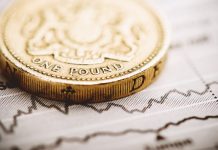The British pound is higher against the US dollar on Thursday.
Sterling survived an early drop in value after a record low in monthly business activity in April according to purchasing managers.
The dollar turned lower after reports the Federal Reserve was planning to expand its money-printing efforts with increased purchases of state and municipal debt.
GBP/USD was up by 36 pips (+0.30%) to 1.2369 as of 5pm GMT.
The currency pair swung in a near-100 pip daily range from lows just above 1.23 to a high of just over 1.24. Yesterday the exchange rate rose +0.26%, meaning a week-to-date decline of -1.08%.
British pound survives worst ever business activity in April
The pound has managed to withstand the worst reading on business activity in history. That is in part because everywhere else is seeing the same, meaning the data adds no relative weakness to the pounds versus other currencies.
Commenting on the results of the PMIs, Markit’s Chris Williamson said: “Business closures and social distancing measures have caused business activity to collapse at a rate vastly exceeding that seen even during the global financial crisis, confirming fears that GDP will slump to a degree previously thought unimaginable in the second quarter due to measures taken to contain the spread of the virus.”
Dollar drops as Fed prepares to buy more local government debt
Data showing another devastating week of American lay -offs coupled with talk of the Federal Reserve ramping up its bond purchases pulled the US dollar lower.
US weekly jobless claims totalled 4.43 million versus the 4.4 million forecast. It’s down from the prior 5.24 million but still a lot of Americans are out of work and a US recession is all but assured based on these figures.
According to the Wall Street journal, the Federal Reserve is looking to buy more state, city and other local government debt up to 2-years in maturity. The purchases on top of all the other programs added by the central bank push the message that it is unconcerned about moral hazard or the devaluation of the dollar that comes with backstopping so much American debt with new money.




